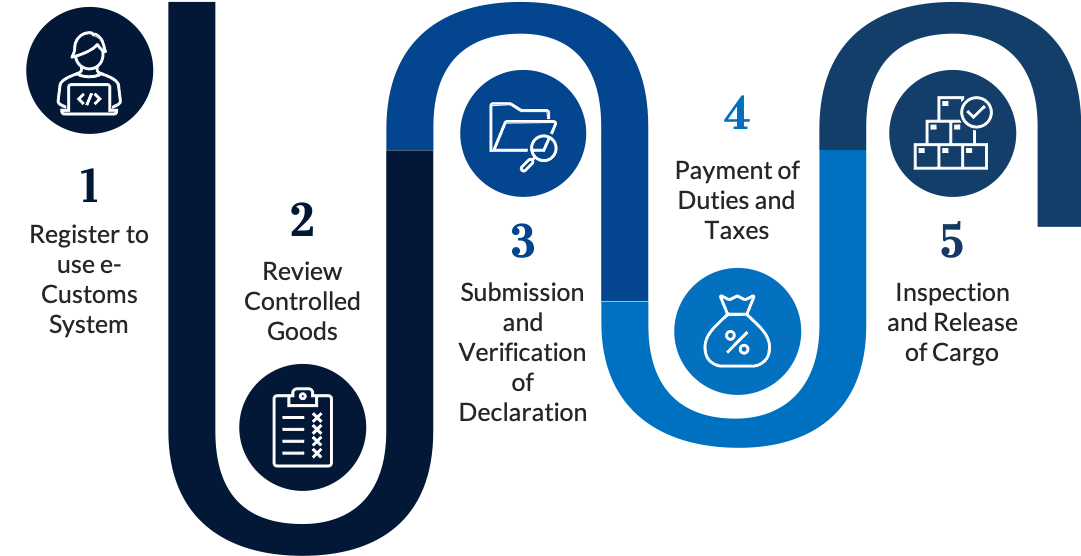Import/Export Licenses
Trading or manufacturing companies are often involved in the import and export of products and raw materials. In Thailand, individuals or companies involved in these activities are required to register with the Thai customs office and apply for an import/export customs paperless license.
The license allows companies to be registered with Thailand’s customs database and perform transactions under the company name for import or export purposes.

Figure. The 5-Step Application Process.
How to Apply for an Import/Export License
Step 1 – Register to use e-Customs System
Importing and exporting goods into Thailand is done via the online e-Customs system. Companies must use a digital certificate, which acts as an electronic signature, to confirm the identity of the person or entity using the system. Online operations in Thailand generally require the use of a digital certificate and import/export registration is no exception.
Companies have the choice of registering for the e-Customs system directly through their own office or with the assistance of an agent. If registering directly, the company must:
✓ Install e-Customs software on the company IT system
✓ Register with the Thai customs office
✓ Test and check the readiness of message exchange with the e-Customers system
Once these steps have been completed, the Communication and IT Bureau will issue an e-Customs registration ID which effectuates the registration process.
Step 2 – Review Controlled Goods
As not all goods require a permit to be imported or exported, companies must check with the Customs Department whether the goods require a permit. For exports, there are around 50 goods categories requiring a permit including trees and seeds.
Importing Red Line Goods
Companies must also ascertain if the goods are classified as ‘red line’ goods. Thai regulations classify red line goods as those which are considered to be high risk or require extra verification and certification. There is not currently a definitive list of red line goods and a company will be informed if its goods are red line upon application. However, common red line goods include food products, drinks and plants. A number of supporting documents are required to import red line goods, including:
✓ Bill of Landing or Air Waybill
✓ Invoice
✓ Packing list
✓ Import License
✓ Certificates of origin
✓ Other relevant documents (e.g. list of ingredients, technical standard certificates etc.)
Exporting Red Line Goods
To export red line goods, companies must submit extra documentation prior to the shipment leaving Thailand. The documents that must be included are the following:
✓ Invoice
✓ Export License
✓ Other relevant documents (e.g. food and drug administration approval, destination information etc.)
Step 3 – Submission and Verification of Declaration
Companies will need to submit the Import or Export Declaration alongside the following supporting documents:
✓ K1 application (pages 1 and 2)
✓ Copy of the company affidavit (updated within six months)
✓ Two copies of value added tax certificate (Phor Phor 20)
✓ Copy of first page of bank account and bank statement
✓ Copy of seal registration (BAJ 3)
✓ Copy of passport
✓ Power of attorney (page 3 of the K1 application)
All documents are checked for completion by customs. Submission will identify if the shipment is red line or green line and will determine duty calculation, customs tariff and valuation of goods.
Step 4 – Payment of Duties and Taxes
Any import/export duties and taxes must be paid by electronic fund transfer through the Bank of Thailand’s BAHTNET, Kung Thai Bank and EDI. Alternatively, payment can be made at the customs department.
Generally, goods imported or exported from Thailand will be subject to duties, however, there are a number of items that are exempt. Companies should check with the customs department to confirm whether or not the goods they are importing/exporting are dutiable.
Step 5 – Inspection and Release of Cargo
Customs requires the importer/exporter to submit the verified Declaration with the payment receipt to the warehouse. After this, the cargo will undergo an inspection before being released. For green line goods, all that is required is a simple online screening. However, for red line goods the supporting documents will be inspected, and the cargo itself will be physically inspected by customs officials. The inspected cargo must correspond with the Declaration. Once this is confirmed, the cargo can be released.
After the Application
Generally, the application process has quite a quick turnaround, and companies can expect to hear back one day after the application. From this, applicants will receive a company license number which will enable them to carry out the import or export of goods. The import/export license is valid for a period of three years.